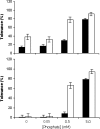Rice-arsenate interactions in hydroponics: a three-gene model for tolerance
- PMID: 18453529
- PMCID: PMC2413283
- DOI: 10.1093/jxb/ern098
Rice-arsenate interactions in hydroponics: a three-gene model for tolerance
Abstract
In this study, the genetic mapping of the tolerance of root growth to 13.3 muM arsenate [As(V)] using the BalaxAzucena population is improved, and candidate genes for further study are identified. A remarkable three-gene model of tolerance is advanced, which appears to involve epistatic interaction between three major genes, two on chromosome 6 and one on chromosome 10. Any combination of two of these genes inherited from the tolerant parent leads to the plant having tolerance. Lists of potential positional candidate genes are presented. These are then refined using whole genome transcriptomics data and bioinformatics. Physiological evidence is also provided that genes related to phosphate transport are unlikely to be behind the genetic loci conferring tolerance. These results offer testable hypotheses for genes related to As(V) tolerance that might offer strategies for mitigating arsenic (As) accumulation in consumed rice.
Figures



Similar articles
-
Rice-arsenate interactions in hydroponics: whole genome transcriptional analysis.J Exp Bot. 2008;59(8):2267-76. doi: 10.1093/jxb/ern097. Epub 2008 May 2. J Exp Bot. 2008. PMID: 18453530 Free PMC article.
-
The role of OsPT8 in arsenate uptake and varietal difference in arsenate tolerance in rice.J Exp Bot. 2016 Nov;67(21):6051-6059. doi: 10.1093/jxb/erw362. Epub 2016 Sep 28. J Exp Bot. 2016. PMID: 27683727
-
Comparative mapping of QTLs for Al tolerance in rice and identification of positional Al-induced genes.J Zhejiang Univ Sci. 2004 Jun;5(6):634-43. doi: 10.1007/BF02840973. J Zhejiang Univ Sci. 2004. PMID: 15101095
-
OsWRKY74, a WRKY transcription factor, modulates tolerance to phosphate starvation in rice.J Exp Bot. 2016 Feb;67(3):947-60. doi: 10.1093/jxb/erv515. Epub 2015 Dec 11. J Exp Bot. 2016. PMID: 26663563 Free PMC article.
-
Biochemical and molecular responses underlying differential arsenic tolerance in rice (Oryza sativa L.).Plant Physiol Biochem. 2016 Jul;104:266-77. doi: 10.1016/j.plaphy.2016.03.034. Epub 2016 Apr 1. Plant Physiol Biochem. 2016. PMID: 27061371
Cited by
-
Identification of QTLs for arsenic accumulation in maize (Zea mays L.) using a RIL population.PLoS One. 2011;6(10):e25646. doi: 10.1371/journal.pone.0025646. Epub 2011 Oct 18. PLoS One. 2011. PMID: 22028786 Free PMC article.
-
Arsenomics: omics of arsenic metabolism in plants.Front Physiol. 2012 Jul 23;3:275. doi: 10.3389/fphys.2012.00275. eCollection 2012. Front Physiol. 2012. PMID: 22934029 Free PMC article.
-
Navigating rice seedling cold resilience: QTL mapping in two inbred line populations and the search for genes.Front Plant Sci. 2023 Dec 14;14:1303651. doi: 10.3389/fpls.2023.1303651. eCollection 2023. Front Plant Sci. 2023. PMID: 38162313 Free PMC article.
-
Genome-wide identification of rice class I metallothionein gene: tissue expression patterns and induction in response to heavy metal stress.Funct Integr Genomics. 2012 Nov;12(4):635-47. doi: 10.1007/s10142-012-0297-9. Epub 2012 Oct 10. Funct Integr Genomics. 2012. PMID: 23053198
-
Recent Advances in Arsenic Research: Significance of Differential Susceptibility and Sustainable Strategies for Mitigation.Front Public Health. 2020 Oct 8;8:464. doi: 10.3389/fpubh.2020.00464. eCollection 2020. Front Public Health. 2020. PMID: 33134234 Free PMC article. Review.
References
-
- Abedin J, Cresser MS, Meharg AA, Feldmann J, Cotter-Howells J. Arsenic accumulation and metabolism in rice (Oryza sativa L.) Environmental Science and Technology. 2002;36:962–968. - PubMed
-
- Aposhian VH, Zakharyan RA, Avram MD, Sampayo-Reyes A, Wollenberg ML. A review of the enzymology of arsenic metabolism and a new potential role of hydrogen peroxide in the detoxication of the trivalent arsenic species. Toxicology and Applied Pharmacology. 2004;198:327–335. - PubMed
-
- Burkhead JL, Abdel-Ghany SE, Morrill JM, Pilon-Smits EAH, Pilon M. The Arabidopsis thaliana CUTA gene encodes an evolutionarily conserved copper binding chloroplast protein. The Plant Journal. 2003;34:856–867. - PubMed
-
- Dasgupta T, Hossain SA, Meharg AA, Price AH. An arsenate tolerance gene on chromosome 6 of rice. New Phytologist. 2004;163:45–49. - PubMed
-
- Kobayashi I, Fujiwara S, Shimogawara K, Sakuma C, Shida Y, Kaise T, Usuda H, Tsuzuki M. High intracellular phosphorus contents exhibit a correlation with arsenate resistance in Chlamydomonas mutants. Plant and Cell Physiology. 2005;46:489–496. - PubMed
Publication types
MeSH terms
Substances
Grants and funding
LinkOut - more resources
Full Text Sources
Research Materials

